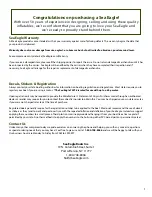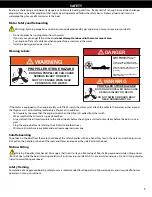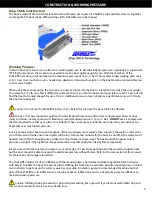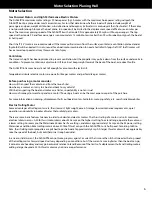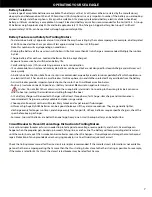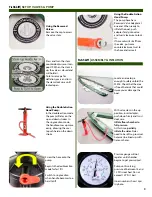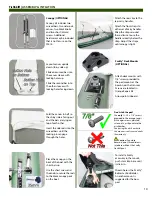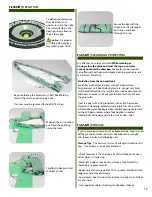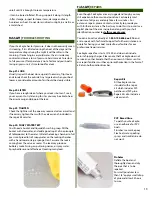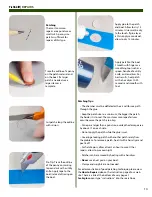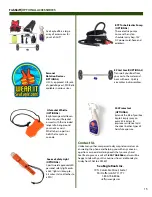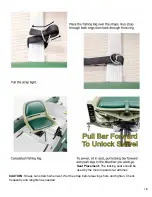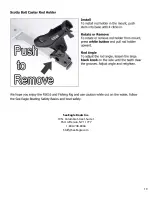
7
Battery Selection
A wide range of acceptable batteries are available. The battery must be 12 volt (unless otherwise stated by the manufacturer),
deep cycle, and between about 20 and 120 Amp Hours (Ah). Amp hours is a very important number, if the battery you are looking
at doesn’t clearly state the amp hours, it may not be suitable. A 12v deep cycle lead-acid battery, electric vehicle (wheelchair)
battery, or lithium ion battery is acceptable. A Group 24 lead-acid battery or smaller is recommended for the FastCat14.4. A Group
24 batteries weigh approximately 50 lbs and hold approximately 75 Ah of charge. A bigger battery, like Group 27 will hold
approximately 100 Ah, can be used but will weigh approximately 60 lbs.
Battery Features and Safety for Trolling Motors
• To determine a battery’s approximate run time, divide the amp hour rating by the motor amperage. For example, a battery rated
at 60 Ah connected to a 30 amp motor will last approximately two hours at full speed.
Note: this number will vary depending on conditions.
• Draining the battery all the way down will shorten its life. Not more than 85% discharge is recommended. Multiply the runtime
by 0.85.
• Charge battery after each use. Lead acid batteries like to be kept charged.
• Exposure to excessive heat will shorten battery life.
• Cold Cranking Amps (CCA) and starting power are not a consideration.
• 12v automobile, lawn tractor and motorcycle batteries can be used but are not designed for deep discharge and will wear out
more quickly.
• A battery box like the Minn Kota Power Center is recommended, especially around aluminum paddle shafts which could cause
an electrical short. It has a built-in circuit breaker. It will keep bare skin and clothes protected if any acid leaks from the battery.
• A circuit breaker provides important protection to the motor. See Circuit Breaker section below.
• Positive (+) red wire connects to positive (+) battery terminal. Black wire to negative terminal (-).
•
Caution:
Do not attach the motor wires to the wrong battery terminals. Connecting to the wrong terminals can cause
wires to heat up, melting the insulation and cutting through the boat.
• A 12v battery charger will be needed. A charger with at least three phases (fast charge, slow charge and maintenance is
recommended. Chargers are widely available and prices range widely.
• Choose gel cell over wet cell. Gel will be less likely to leak acid or get ruined if submerged.
• Lithium or high quality AGM batteries can be a good choice even if they are more expensive. They are generally lighter,
discharge evenly for longer run times, and charge evenly for a longer life. Lithium batteries require specific chargers, check the
specs before buying a charger.
• For some, two small batteries are better than one large, heavy one. A small backup battery can be helpful too.
Circuit Breaker to Prevent Overvoltage Distruction to Trolling Motors
A circuit interrupter (breaker or fuse) is needed to protect against overvoltage, reverse polarity, and shorts. Overvoltage can
happen when the propeller gets bound up in weeds, fishing line, or anchor line. The battery will keep providing electric current
until the motor burns out. Often smoke can be smelled or seen when this happens. Overvoltage can damage the motor beyond
repair. Protection of an ungrounded current-carrying conductor is a Coast Guard requirement as well.
Check the trolling motor manual for the size circuit interrupter recommended. If the manufacturer’s information is not available,
get one that has an amperage rating that is more than the thrust rating, but as close to the thrust rating as possible. For example,
if the motor is rated for 45 lbs thrust, the closest rated breaker may be rated for 50 amps.
OPERATING YOUR SEA EAGLE
Содержание FishSkiff FSK16
Страница 17: ...16 ...
Страница 18: ...17 ...
Страница 20: ...19 Sea Eagle Boats Inc 19 N Columbia Street Suite 1 Port Jefferson NY 11777 1 800 748 8066 Staff SeaEagle com ...


